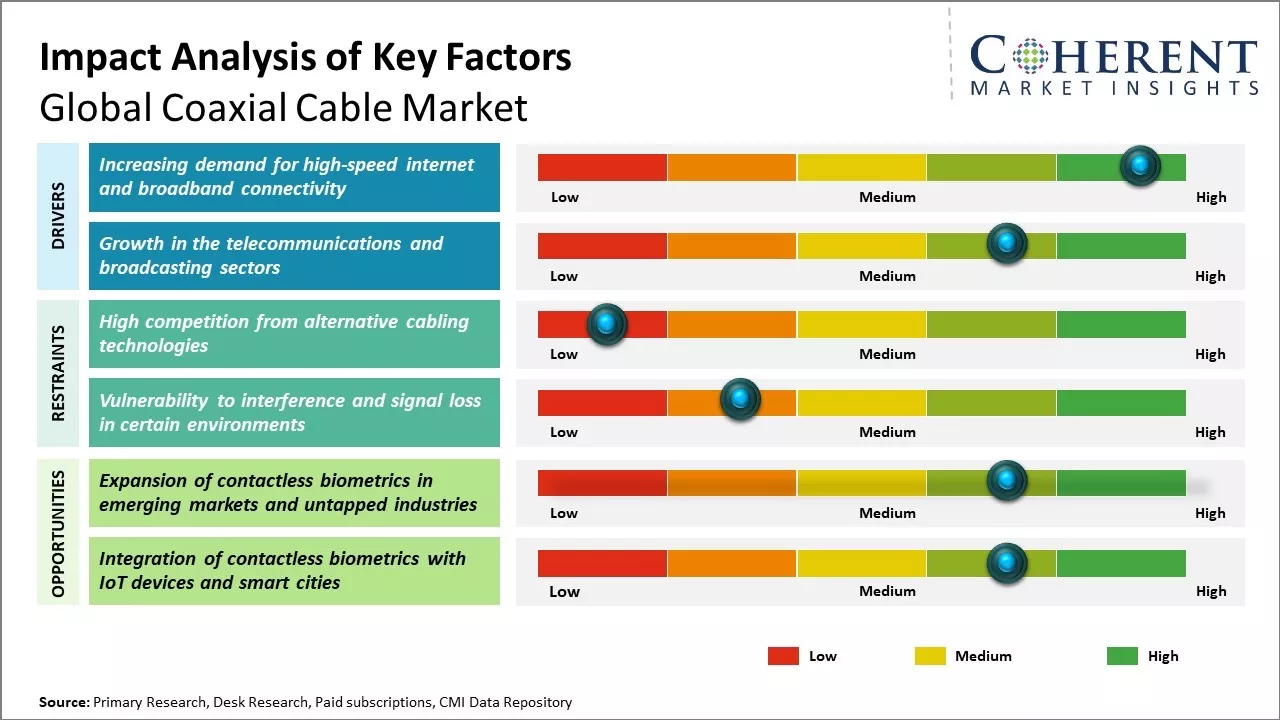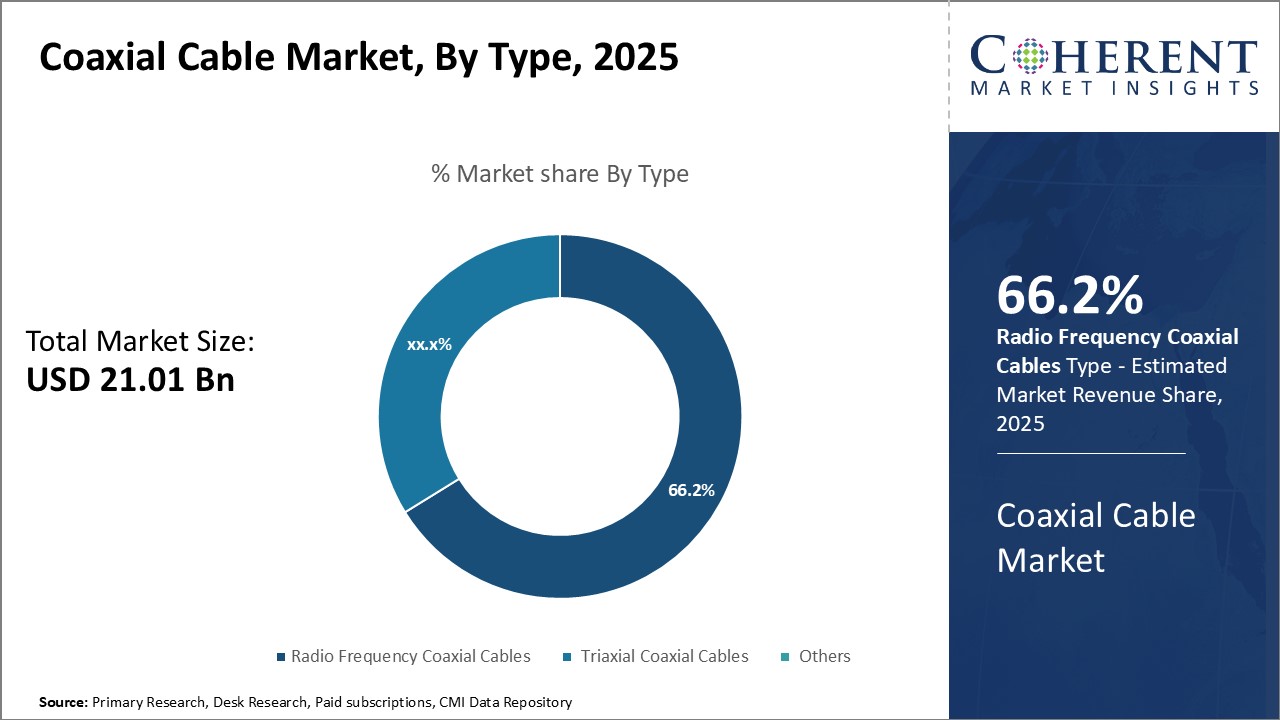Coaxial Cable Market Size and Trends
The global coaxial cable market is estimated to be valued at US$ 21.01 Bn in 2025 and is expected to reach US$ 36.03 Bn by 2032, exhibiting a compound annual growth rate (CAGR) of 8.0% from 2025 to 2032.

Discover market dynamics shaping the industry: Download Free Sample
Wide applications of coaxial cables across television distribution systems, cable television, and broadband internet are promoting the demand for coaxial cables. Additionally, increasing investments by service providers to enhance connectivity infrastructure and expand internet coverage to rural areas will also contribute to the market growth. Moreover, rising demand for high-speed internet and growing penetration of multimedia devices and smart home appliances are further expected to drive the coaxial cable market during the forecast period.
Increasing demand for high-speed internet and broadband connectivity
With more people working from home and relying on fast internet connections for streaming, video conferencing, online classes, and more each day, the demand for high-speed internet has increased dramatically across the globe. Coaxial cables play a vital role in delivering broadband internet into homes and offices as they are able to support much higher bandwidth speeds compared to traditional copper wires. They have become the preferred medium for internet service providers looking to offer subscribers speeds of over 100 Mbps which is considered broadband as per current FCC regulations in many countries.
As people expect lightning-fast load times and minimal interruptions online, providers are under pressure to upgrade their infrastructure to fiber or coaxial networks that can handle today’s data-heavy usages. This has led to billions being poured into network expansion projects focused on deploying fiber deeper into neighborhoods right up to the premises while using coaxial cables for the last mile connectivity. 5G rollout has also increased the need for high-bandwidth backhaul connections between cell towers and the core network, for which coaxial cables provide a cost-effective solution able to meet capacity needs.
With work from home and online learning here to stay even post pandemic, guaranteeing smooth video calls and streaming is paramount. This sustained rise in bandwidth demand can only be met through networks empowered by coaxial infrastructure. While providers scramble to enhance networks nationwide to maintain lucrative high-speed internet subscriber bases, it spurs greater usage of coaxial cables, driving significant market growth.
Market Concentration and Competitive Landscape

Get actionable strategies to beat competition: Download Free Sample
Growth in the Telecommunications and Broadcasting Sectors
The telecommunication and broadcasting industries have been rapidly evolving due to trends like increased smartphone and cable TV penetration, proliferation of Over-The-Top (OTT) media services, and migration to newer broadcast technologies such as IP and fiber networks. All of this has led to exponential growth in network traffic volumes as well as changes in infrastructure requirements. Coaxial cables play a vital supporting role for telecom and TV networks undergoing revamps.
In the telecom domain, coaxial cables are being widely used for FTTx deployments as the last mile connectivity between fiber nodes and customer points. They continue delivering linear TV and also carry high-speed internet into homes for cable MSOs and telecom operators. 5G rollouts across regions have surged the need for faster, high-capacity backhaul links between cell sites and the core using coaxial cables. Pay TV subscribers are also rising in developing nations, increasing broadcast network upgrades using coaxial transmission systems.
OTT streaming has put pressure on networks to efficiently manage traffic. Edge computing deployments are happening to reduce latencies for smooth streaming and connectivity. This involves shifting network assets closer to end-users, again driving deployment of coaxial cables. Evolving broadcast standards such as DOCSIS for cable and ATSC 3.0 for terrestrial TV have stimulated network modernization projects too. With demand across both established and new domains within telecoms and broadcasting expanding continuously, it ensures good growth opportunities for coaxial cable suppliers.
For instance, in June 2021, CommScope Holding Company, Inc., a global leader in network infrastructure solutions, announced the acquisition of the coaxial cable business of Shenzhen Kingsun Science and Technology Co., Ltd., a prominent manufacturer based in China. This strategic move aimed to strengthen CommScope's position as a leading provider of high-performance coaxial cables for various applications, including telecommunications, broadcasting, and networking.
Key Takeaways from Analyst:
5G deployment around the world will be one of the main drivers of demand as 5G networks require higher bandwidth offered by coaxial cables for backhaul. Areas with increasing fixed broadband penetration along with fiberization of cable networks will boost market opportunities. North America will continue their dominance due to well-established pay-tv markets and dense population coverage. However, Asia Pacific is likely to witness the fastest growth spurred by the growth of internet users in China and India as well as increasing investments by telecom operators in these countries toward enhancing network connectivity.
On the other hand, wireless technologies like 4G and emerging 5G may pose a restraint as they offer similar bandwidth and can substitute wired connectivity. Increasing fiber to the home connections is another challenge by providing higher speeds. Product innovations and development of thinner and more flexible designs could help mitigate the impact of restraints. Moreover, coaxial cables find increasing usage in data centers for faster transfer of large files and connecting various network equipment, opening new avenues of growth. Overall, the market is expected to perform steadily with networking requirements expanding across industries.
Market Challenge - High competition from alternative cabling technologies
The global coaxial cable market is facing intense competition from other alternative cabling technologies such as fiber optics cable. Fiber optics cable has emerged as a more future proof and high-speed technology compared to conventional coaxial cables. It can offer much higher bandwidth and bigger network capacity to support growing data transmission needs. Telecom operators and ISPs are increasingly upgrading their network infrastructure with fiber optics to offer data speeds like 5G in future. This is negatively impacting demand for coaxial cables. Furthermore, wireless technologies like WiFi are also substituting short-distance coaxial connections within buildings. With ever increasing demand for high broadband speeds, consumers are also willing to pay more for advanced fiber optics networks. Unless coaxial cable manufacturers focus on further improving their product portfolio to meet high-speed networking needs, their market share could decline substantially in coming years.
Market Opportunity: Expansion of contactless biometrics in emerging markets and untapped industries for market
The global coaxial cable market has huge untapped growth opportunity in expanding adoption of contactless biometrics solutions across developing countries like U.S., Canada, China, etc. Biometric technologies that use radio frequency signals for contactless fingerprint and face authentication require specialized coaxial cables to transmit signals with high accuracy over certain distances. Many emerging markets in Asia Pacific and Latin America still have very low penetration of biometric access control systems in commercial buildings, transportation facilities and manufacturing plants. As these countries continue to urbanize and enhance infrastructure security, demand for coaxial cables from biometric system integrators is expected to surge. Even within developed industries, certain sectors like healthcare, education, retail have lagged behind in deploying biometrics. If coaxial cable manufacturers strategically target these emerging applications, they can tap into long term sales opportunities beyond traditional ICT and cable TV segments.

Discover high revenue pocket segments and roadmap to it: Download Free Sample
Insights By Type - Reliability and Wide Applications Drive Radio Frequency Coaxial Cables
In terms of type, radio frequency coaxial cables contributes 66.2% share of the market in 2025 owing to its reliability and ability to support a wide range of applications. Radio Frequency coaxial cables use either solid or stranded copper or copper-clad steel conductors to transfer electrical signals with minimal resistance. The conductor is surrounded by a protective insulating layer of polyethylene foam or plastic to reduce interference. A protective outer conductor shell and optional outer protective plastic jacket complete the cable structure.
This layered construction provides excellent electromagnetic shielding and noise isolation. Signals are transmitted cleanly through the inner conductor while external electromagnetic interference is contained within the outer conductor. The insulating layer maintains a fixed spacing between the inner and outer conductors, establishing a consistent impedance that allows radio frequency coaxial cables to efficiently transmit radio waves and high frequency signals over long distances.
The ability to carry broadband RF signals reliably makes radio frequency coaxial cables ideal for applications like cable television, wireless networks, broadcast transmission, and telephone networks. Cable television providers depend on coaxial cables to deliver hundreds of television and radio channels into homes simultaneously without signal degradation. Wireless carriers use coaxial backhaul cables to connect cell towers to network equipment handling 2G, 3G, 4G and emerging 5G services. Broadcast stations worldwide transmit audio and video content over coaxial lines with low attenuation. Telecom networks lay extensive coaxial trunk lines to carry telephone calls and data transmissions between switching centers.
Additional widespread uses of radio frequency coaxial cables include antenna and satellite dish connections, closed circuit security cameras, audio-visual systems, and industrial machine control applications requiring interference-free transmission of control signals over longer distances. Their shielding properties and broadband frequency handling make them uniquely suited to replace other media in applications transitioning to higher data rates and bandwidth needs. Overall demand for bandwidth expansion and robust transmission of high frequency RF signals across various industries continues driving reliance on and market share of radio frequency coaxial cables.
Insights By Material - Electrical Conductivity Drives Copper's Dominance as Preferred Coaxial Cable Material
In terms of material, copper contributes 60.6% share of the market in 2025 owing to its superior electrical conductivity. Copper is an excellent conductor of electricity, excelling other potential materials like aluminum. It has low electrical resistance, allowing it to transmit electrical signals over long distances with minimal power loss. Copper also exhibits nearly temperature-independent resistance, meaning cables made from copper can transmit signals effectively in varied ambient temperature conditions faced outdoors or in industrial environments.
Additionally, copper is not easily oxidized like aluminum and does not require special surface coatings for corrosion resistance when exposed to air and moisture over the lifespan of underground or aerial transmission cables. This reduces maintenance needs compared to other materials. Copper also shows high ductility and is easily drawn into thin wires for interior conductor elements in coaxial cables. Its malleability allows accurate dimensional control during manufacturing for consistency in electrical properties.
The electrical conductivity properties of copper are critical for applications like cable television networks, cellular backhaul, broadcast transmission and telecom trunk lines that depend on coaxial cables for transmission of large volumes of data, voice and video signals simultaneously with low noise and loss. Copper cables ensure reliable transmission of electromagnetic signals even over long distances, futureproofing networks to support higher frequencies and bandwidth needs from emerging technologies. This drives its dominance as the preferred material for coaxial cable construction where quality transmission is essential.
Insights By Application - Expanding Network Infrastructure and Proliferating Devices Fuel Telecommunications' Leading Share
In terms of application, telecommunications contributes 41.7% share to the global coaxial cable market in 2025 owing to the massive infrastructure required to support ever-growing demand for wireless connectivity and bandwidth-intensive new services. 5G cellular network deployments alone are expected to necessitate installation of hundreds of thousands of new cell towers and small cells worldwide in the coming years. This will drive extensive requirements for high-capacity backhaul cables to physically connect this infrastructure to network equipment.
Additionally, telecom operators are continually upgrading and expanding wireline network backbone infrastructures with new fiber routes and coaxial feeder lines to deliver multi-gigabit broadband connectivity and FTTx to more homes and businesses. Cable operators also leverage coaxial networks for bandwidth-intensive applications beyond traditional TV such as broadband data, VOIP telephony and emerging applications such as smart city infrastructure management and connectivity of IoT devices.
Proliferation of network-connected devices is another key driver, as every additional device on cellular or cable networks placing further demand on transmission infrastructure. By 2025, there are expected to be over 25 billion networked devices globally. This expansion of endpoints necessitates greater network capacity through technologies like 5G, WiFi6, and 10G broadband - all relying on robust coaxial backbone and access networks using various cable types.
Regional Insights

Need a Different Region or Segment? Download Free Sample
North America has established itself as the dominant region in the global coaxial cable market 36.1% share in 2025. The well-established telecommunications and cable television industries in countries like the U.S. and Canada have created significant demand for coaxial cables over the years. Major industry players from the region such as CommScope and Belden have grown to become leading global providers and set the standards for coaxial cable designs. In addition, consumption of broadband services has also been high in North America, further driving the need for high-quality coaxial infrastructure. With high investments in networking by both businesses and consumers, North America continues to account for the largest share in the global coaxial cable market.
For instance, in April 2023, Prysmian Group North America, a leading manufacturer of energy and telecommunications cable systems, announced the expansion of its manufacturing facility in Williamsport, Pennsylvania, to significantly increase production capacity. This expansion includes a 51,000-square-foot addition to the existing plant, which will double the company's ability to manufacture advanced transmission conductors utilizing its innovative E3X technology.
The Asia Pacific region has emerged as the fastest growing regional market for coaxial cables. Several factors such as rising infrastructure development, growing urbanization, and increasing digitization are fueling market expansion in Asia Pacific. Country markets with high growth potential include China and India, where various government initiatives are actively improving network connectivity. Both nations have witnessed exponential increases in internet and cable TV subscribers in recent times. Additionally, many manufacturing hubs have shifted base to Asia Pacific, where coaxial cable is a necessity for industrial applications as well. Leading regional suppliers including LS Cable and Nexans are playing a significant role in meeting the rising product demand from within. With vast opportunities across telecom, broadband, and industrial domains, Asia Pacific is expected to see continued rapid coaxial cable market expansion over the coming years.
Market Report Scope
Coaxial Cable Market Report Coverage
| Report Coverage | Details | ||
|---|---|---|---|
| Base Year: | 2024 | Market Size in 2025: | USD 21.01 Bn |
| Historical Data for: | 2020 To 2024 | Forecast Period: | 2025 To 2032 |
| Forecast Period 2025 to 2032 CAGR: | 8.0% | 2032 Value Projection: | USD 36.03 Bn |
| Geographies covered: |
|
||
| Segments covered: |
|
||
| Companies covered: |
Belden Inc., Amphenol Corporation, CommScope Holding Company, Inc., Nexans S.A., Prysmian Group, General Cable, Southwire Company, LLC, RS Components Ltd., Sumitomo Electric Industries, Ltd., Huawei Technologies Co., Ltd., CCA (Cables and Connectors), L-com Global Connectivity, Times Microwave Systems, Teledyne Technologies Incorporated, and AFL Global |
||
| Growth Drivers: |
|
||
| Restraints & Challenges: |
|
||
Uncover macros and micros vetted on 75+ parameters: Get instant access to report
Coaxial Cable Industry News
- In January 2024, Southwire Company, a leading North America-based manufacturer of wire and cable products, announced a partnership agreement with Swiss manufacturer, Kummler+Matter AG (K+M), to innovate in cable manufacturing processes. This strategic alliance aims to leverage the expertise and technologies of both companies to enhance Southwire's cable production capabilities and drive advancements in the industry.
- In September 2023, Amphenol Corporation, a global leader in interconnect, antenna, and sensor solutions, launched a new line of lightweight coaxial cables specifically designed for broadcasting applications. This innovative product line aims to meet the growing demands of the broadcasting industry for high-performance, efficient, and easy-to-install cable solutions.
- In February 2022, Comcast Cable, a subsidiary of Comcast Corporation, announced a collaboration with Echo Environmental Holdings, LLC, a subsidiary of Envela Corporation, to implement an innovative recycling solution for its coaxial cable products. This partnership aims to significantly reduce landfill waste by recycling old coaxial cables into reusable materials, thereby promoting sustainability within the telecommunications industry.
- In February 2021, Belden Inc., a leading global supplier of specialty networking cables, announced the launch of its new series of high-performance coaxial cables optimized for 5G applications. This innovative product line, developed by Belden's team of experts, aims to support the growing demand for reliable and efficient connectivity solutions in the rapidly evolving 5G landscape.
*Definition: The global coaxial cable market refers to the market for coaxial cables worldwide that are used primarily for carrying radio frequency signals to and from television receivers, cable television equipment, satellite television receivers, computers with television tuner cards, and other radio frequency applications. Coaxial cables are commonly used to transmit cable television signals, broadband internet connections, and connect broadcast network equipment. They provide better signal quality and higher bandwidth compared to ordinary twin lead cables.
Market Segmentation
- By Type Insights (Revenue, US$ Bn, 2020 - 2032)
-
- Radio Frequency Coaxial Cables
- Triaxial Coaxial Cables
- Others
- By Material Insights (Revenue, US$ Bn, 2020 - 2032)
-
- Copper
- Aluminum
- Others
- By Application Insights (Revenue, US$ Bn, 2020 - 2032)
-
- Telecommunications
- Broadcasting
- Data Networking
- Security and Surveillance
- Others
- Regional Insights (Revenue, US$ Bn, 2020 - 2032)
- North America
- U.S.
- Canada
- Latin America
- Brazil
- Argentina
- Mexico
- Rest of Latin America
- Europe
- Germany
- U.K.
- Spain
- France
- Italy
- Russia
- Rest of Europe
- Asia Pacific
- China
- India
- Japan
- Australia
- South Korea
- ASEAN
- Rest of Asia Pacific
- Middle East
- GCC Countries
- Israel
- Rest of Middle East
- Africa
- South Africa
- North Africa
- Central Africa
- North America
- Key Players Insights
-
- Belden Inc.
- Amphenol Corporation
- CommScope Holding Company, Inc.
- Nexans S.A.
- Prysmian Group
- General Cable
- Southwire Company, LLC
- RS Components Ltd.
- Sumitomo Electric Industries, Ltd.
- Huawei Technologies Co., Ltd.
- CCA (Cables and Connectors)
- L-com Global Connectivity
- Times Microwave Systems
- Teledyne Technologies Incorporated
- AFL Global
Share
Share
About Author
Suraj Bhanudas Jagtap is a seasoned Senior Management Consultant with over 7 years of experience. He has served Fortune 500 companies and startups, helping clients with cross broader expansion and market entry access strategies. He has played significant role in offering strategic viewpoints and actionable insights for various client’s projects including demand analysis, and competitive analysis, identifying right channel partner among others.
Missing comfort of reading report in your local language? Find your preferred language :
Transform your Strategy with Exclusive Trending Reports :
Frequently Asked Questions
EXISTING CLIENTELE
Joining thousands of companies around the world committed to making the Excellent Business Solutions.
View All Our Clients
